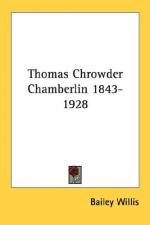|
This section contains 391 words (approx. 2 pages at 300 words per page) |
Encyclopedia of World Biography on Thomas Chrowder Chamberlin
Thomas Chrowder Chamberlin (1843-1928), the leading American geologist of his time, was known primarily as a glacialist and as an outstanding contributor to theoretical geology, particularly for his "planetesimal" theory of the origin of the planets.
Thomas Chamberlin was born on Sept. 25, 1843, in Mattoon, III., the son of a Methodist minister. In 1866 Chamberlin received a bachelor of arts degree from Beloit College and the next year married Alma Wilson. After a year of graduate study at the University of Wisconsin he became professor of natural sciences at the State Normal School, Whitewater, Wis. (1870-1873).
Chamberlin then went to Beloit College as professor of geology and began his career as a student of earth history. The glacial deposits around Beloit revealed dramatically that the climatic conditions in past ages differed sharply from current conditions. Chamberlin followed this obvious fact into a consideration of earth climates through the known range of geological time and finally into problems of cosmic physics.
While at Beloit, Chamberlin also served as an assistant on the Wisconsin State Survey (1873-1876) and as its chief (1877-1882). The results of the comprehensive survey, published in four volumes, attracted so much favorable attention that a Division of Glacial Geology was established in the U.S. Geological Survey, with Chamberlin as head (1882-1887). For the next 5 years he was president of the University of Chicago as head of the department of geology and director of the Waller Museum, becoming professor emeritus in 1919. In 1893 he founded the Journal of Geology and was editor in chief until 1922. He died on Nov. 15, 1928.
His "Planetesimal" Theory
In the late 1890s Chamberlin began the series of papers which led to his "planetesimal" hypothesis. This was stated in its final form in The Origin of the Earth (1916). He drew upon a wide range of investigations in mathematics and astronomy and brought practically the whole field of cosmic physics to bear upon the problem. His theory grew out of efforts to test the long-standing nebular hypothesis. Chamberlin proposed that a star crossing close to the path of the sun caused a partial disruption of the sun. Materials were expelled and formed into great and small masses. Swarms of the minute particles solidified into what Chamberlin called "planetesimals." These in turn were drawn into the larger masses, which, moving in elliptical orbits, formed the planets of the solar system.
|
This section contains 391 words (approx. 2 pages at 300 words per page) |


